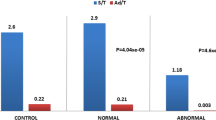Summary
In 124 selected autopsy cases we found 27 cases with so-called hypoplastic zones in scrotal and otherwise normal testes. In seven cases both sides were affected. The frequency of hypoplastic zones diminishes with increasing age. The significance of this fact is discussed. We conclude that hypoplastic zones should not be considered as a sign of major congenital defect.
Zusammenfassung
In einer Gruppe von 124 ausgewählten Autopsien von Männern im Alter zwischen 15 und 39 Jahren konnten bei 20 Fällen in einem der beiden Hoden, bei 7 Fällen in beiden Hoden, hypoplastische Zonen nachgewiesen werden. Die Häufigkeit der hypoplastischen Zonen nimmt mit zunehmendem Alter rasch ab. In Anbetracht der großen Häufigkeit hypoplastischer Zonen dürften derartige Herde in descendierten und sonst normalen Hoden nicht als belangreiche Mißbildung gedeutet werden.
Similar content being viewed by others
References
Collins, D. H., andT. Symington: Sertoli-cell-tumor. Brit. J. Urol.36, Suppl. 52–61 (1964).
Guillemin, J.: Les cryptorchidies, état actuel de la question. Sem. Hôp. Paris40, 1489–1492 (1964).
Halley, J. B. W.: The growth of sertoli-cell-tumors: A possible index of differential gonadotrophin activity in the male. J. Urol. (Baltimore)90, 220–229 (1963).
Hedinger, Chr., u.D. Plattner: Dysgenetische sogenannte hypoplastische Zonen im retinierten und beidseits normal deszendierten Hoden. Path. et Microbiol.24, 227–233 (1961).
Johnston, J. H.: The undescended testis. Arch. Dis. Childh.40, 113–122 (1965).
Kochenburger: Die Mißbildungen der weiblichen Genitalien. Z. Geburtsh. Gynäk.26, 60–77 (1893).
Lecène, P., etM. Chevassu: L'adénome vrai dans le testicule ectopique. Rev. Chir. (Paris)35, 234–244 (1907).
Plattner, D.: Hypoplastische und keimepithelfreie Zonen in beidseits deszendierten Hoden als Zeichen einer partiellen Dysgenesie. Virchows Arch. path. Anat.335, 598–616 (1962).
Sohval, A. R.: Testicular dysgenesis as an etiologic factor in cryptorchidism. J. Urol. (Baltimore)72, 693–702 (1954).
Author information
Authors and Affiliations
Additional information
This investigation was aided by a grant of the “Emil-Barell-Stiftung“ of the F. Hoffmann-La Roche and Co., Inc., Basle, Switzerland.
Rights and permissions
About this article
Cite this article
Hedinger, C.E., Huber, R. & Weber, E. Frequency of so-called hypoplastic or dysgenetic zones in scrotal and otherwise normal human testes. Virchows Arch. path Anat. 342, 165–168 (1967). https://doi.org/10.1007/BF00960585
Received:
Issue Date:
DOI: https://doi.org/10.1007/BF00960585



